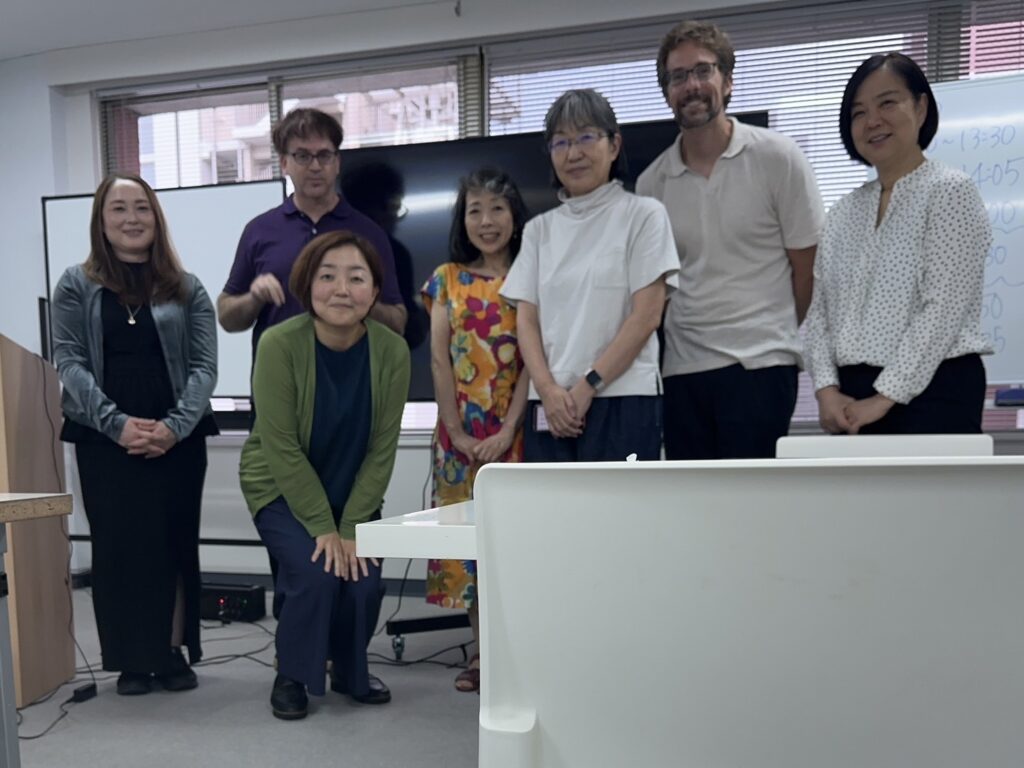日時:2024年12月22日(日)11:00開始
会場:麗澤大学新宿キャンパス 新宿アイランドタワー4階4104号
大会プログラム
開催形態:対面開催(発表は会場で行います。オンライン発表はありません)
※1.遠隔参加する聴講者向けに、リアルタイム中継(配信)を行います。
対面開催で実施するため、発表者は会場にお越しください。聴講につきましては、会の盛況のためにもなるべく会場にお越しいただけましたら幸いです。
※2.オンラインで参加される方は、以下のGoogle formsにてご登録ください。 〆切:12月20日(金)23:59 後日ZoomのURLをお知らせします。
参加事前登録: https://docs.google.com/forms/d/e/1FAIpQLSeNi68hoKG4pd1fFDZOaiAwxd1WBr_T8S2SevhEEIbZD4Z7Rw/viewform?usp=sharing
※3.ワークショップでのPC使用の推奨
17:35 – 18:35の時間帯に招待講演/ワークショップを行います。ワークショップはスマホでも体験はできますが画面が小さく操作しにくいので、PCやタブレットの持参をおすすめ致します。文字入力・編集作業があるためPCの方が便利です。ワークショップ実施後、体験してくださった皆様から使用感の感想や活用方法の提案を頂くアンケートへのご協力をお願いできますと幸いです。アンケートへの回答は5分程度で終わります。
※4. 支部大会の後に懇親会を予定しております。(事前予約制)
参加ご希望の方は、こちらの懇親会参加フォーム(Google forms)にて申し込みください。 [〆切: 12月20日(金)23:59]
第15回東日本支部大会 懇親会申し込みフォーム
プログラム
11:00-11:30 受付Registration & 発表者リハ(希望者)
Rehearsal for presenters(optional)
11:30-11:35 開会挨拶Opening ceremony
11:35 – 12:00 発表1(20分 + QA5分)
“A Consideration of the Effectiveness of English Language Films usage in the ESL Classroom”
SEKIGUCHI, Mio (Nagoya University and University of Maryland, Chubu Chapter) & ZUBIATE,
Miguel (Centro de Idiomas de Apaseo el Grande, Mexico)
12:05 – 12:30 発表2(20分 + QA5分)
「英語総合教材で採用されるニュース動画の語彙特性」 山本五郎(法政大学・東日本支部)
12:35 – 13:00 発表3(20分 + QA5分)
「英語学ゼミにおけるPBLの試み:映画や海外ドラマのセリフにおける文頭省略を題材に」 渡邊 信( 麗澤大学・東日本支部)
13:30 – 14:20 昼休み(50分)
14:20 – 14:35 総会(15分)
14:35 – 15:00 発表5(20分 + QA5分)
「wh-平叙疑問文の生起環境と語用論的機能について―映画・海外ドラマからの実例に基づく 記述的分析―」 三村仁彦(帝塚山大学・西日本支部)
15:05 – 15:30 発表6(20分 + QA5分)
「映像・活字メディアから動きと描写を表す語彙を学ぶ」 横山仁視(京都女子大学・西日本支部)
15:35 – 16:00 発表7(20分 + QA5分)
「Romeo and Juliet (1968)と若者文化の断層 ―人種問題への無理解とホモセクシュアルパニック の交錯―」 内藤みのり(東京科学大学)、小泉勇人(東京科学大学・東日本支部)
16:05 – 16:30 発表8(20分 + QA5分)
「“What’s the difference?” ―映画『歩道の三人女』にみるアメリカ文化」 飯島さや(武蔵野音楽大学・東日本支部)
16:35 – 17:00 発表9(20分 + QA5分)
「音声英語に見られる息継ぎの特徴」 原田知子(武蔵野音楽大学・東日本支部)
17:05 – 17:30 発表10(20分 + QA5分)
「ガクチカ動画と行動面接(STAR)によるスピーキング強化」 佐藤真奈美(京都先端科学大学・西日本支部)
17:35 – 18:35 招待講演/ワークショップ(50分+QA10分)
「テキスト音声化サービスVOXXで英語教材を作る」 ファシリテイト: 山口直彦(東京国際工科専門職大学) サポート: 石田尚人(東京国際工科専門職大学)
18:35 – 18:40 閉会の挨拶 Closing ceremony
19:00-21:00 懇親会Party
プロシーディング(Proceedings)
1.11:35 – 12:00 発表1 (20分 + QA5分)
“A Consideration of the Effectiveness of English Language Films usage in the ESL Classroom”
SEKIGUCHI, Mio (Nagoya University and University of Maryland) ZUBIATE, Miguel (Centro de Idiomas de Apaseo el Grande, Mexico)
Abstract:In recent years, second language education using Internet materials as a tool has become common: Youtube, Nexflix, and other sites offer free or low-cost access to movies, documentaries music videos, and other videos of all genres. Teachers can also create their teaching materials and upload their Youtube videos. In this presentation, we will focus on what kind of teaching materials, especially movies, ESL classes’ students can easily accept and compare them with examples from Japan and the U.S.
At first, Zubiate will introduce his experiences as a case of Saddleback High School in the City of Santa Ana in California. The setting condition in this research is that the classes have students of one race in every ESL class. The ESL class in Japan had all Japanese students, while all students in ESL classes at Saddleback High School were from Mexico. Zubiate will consider effective films for English classes to Japanese students through his experiences in California. Sekiguchi will introduce Japanese American movies and novels to Japanese students’ classes. She has several experiences and activities with Japanese-Americans in California and Hawaii. Through our experience, we conclude that the use and application of resources from similar racial backgrounds will help non-native students feel empowered to acquire the English language.
2.12:05 – 12:30 発表2 (20分 + QA5分)
「英語総合教材で採用されるニュース動画の語彙特性」
山本五郎(法政大学)
概要: 大学における教養科目としての英語教育では、学部や学科の専門領域の研究論文や専門書等の文献を対象とした内容よりも、実用的な語学活動や発信力を高めるための英語教育が提供されるのが一般的である。そのような一般教養の英語科目で採用される教材の多くは、動画や音声などの視聴覚素材を盛り込んで作成されていることが多い。教材内の視聴覚素材として実際のニュース動画を用いる場合、その難易度については調整できないことが通例である。このような背景を踏まえ、本研究ではSDGs, Well-Being, Work-Life Balanceなどの現代社会の象徴的な理念をテーマにして作成された大学生向けの英語総合教材を複数取り上げ、教材で採用されている時事ニュースの動画クリップで使用されている語彙に注目する。ニュース動画の語彙リストを基に英和辞書の語彙レベルとの比較分析等を通して、学士課程における語彙学習の観点からニュース動画の語彙特性について考察する。
3.12:35 – 13:00 発表3 (20分 + QA5分)
「英語学ゼミにおけるPBLの試み: 映画や海外ドラマのセリフにおける文頭省略を題材に 」
渡邊 信(麗澤大学)
概要: 本発表では私が担当する英語学ゼミにおける洋画や海外ドラマのセリフを題材としたPBLの試みを紹介します。具体的には、カジュアルな口語英語でしばしば用いられる<パターン化された文頭省略>に関して考察します。例えば 以下の例文では2重取り消し部分は実際には発音されません):
(1) I don’t know what’s gone wrong here.
(2) Have you been eating the biscuits again?
(3) Have you started yet?
(4) Put your hands up. ((1)-(4)はCarter & McCarthy (2006)より)
頻度の高い省略ですが、私の学生の大半は<英文には主語がある>と固く信じているのでこの事実には驚きのようです。ゼミ学生は各々以下の課題に取り組みます:
1. 英語の映画/海外ドラマから文頭省略を100例抜き出しなさい。ただし命令文(e.g., Come here) などは主語の省略と見なさないこと(命令文は主語のないものが無標(普通))。 2. 何が省略されているかに基づき分類しなさい。何パターンの文頭省略を確認しましたか? 3. どのパターンの文頭省略を何例見つけることができましたか? 例としてThe Big Bang Theoryの分析結果を紹介します。
引用文献 Carter, R., & McCarthy, M. (2006). Cambridge grammar of English. Cambridge University Press. 渡邊信. (2022). 英語平叙疑問文のバイアス: 一般化と反例の扱い. 『麗澤レヴュー(Reitaku Review)』, 28, 46-52.
13:30 – 14:20 昼休み(50分)
14:20 – 14:35 総会(15分)
5.14:35 – 15:00 発表5 (20分 + QA5分)
「wh-平叙疑問文の生起環境と語用論的機能に ついて―映画・海外ドラマからの実例に基づく記述的分析―」
三村仁彦(帝塚山大学)
概要: 本発表では,wh-平叙疑問文について,映画および海外ドラマのセリフから抜粋した実例をもとに,その生起環境と機能について議論する。具体的には,下記(1)のようなwh-平叙疑問文は,通常のwh-疑問文と異なり,(2)の前提を必要とし,意味的には(3)のような特性をもつことを明らかにする。
(1) Gemma: Tess, your silence indicates what? 『M3GAN/ミーガン』(M3GAN, 2022)<0:30:45> (2) 話し手は聞き手が質問に対する答えを有していると強く確信している。 (3) a. 感情的な発話であり,話し手の驚きや不満,好奇心を表す。 b. 聞き手からの反応をより強く要求し,談話の進行を促すはたらきをもつ。 また,(4)のようないわゆる「クイズ疑問文」との違いについても触れる。 (4) The Striding Man is the log of what sprits company? 『クイズ・レディー』(Quiz Lady, 2023)<1:11:16>
6.15:05 – 15:30 発表6 (20分 + QA5分)
「映像・活字メディアから動きと描写を表す語彙を学ぶ」
横山仁視(京都女子大学)
概要: 語彙学習は「1:1」として学習することはその使用範囲を学習者自らが狭めることにつながる。一方で学習年齢や学習者の興味の対象が増すにつれ様々なジャンルの映像(活字) メディアから拡張した使用を身に付けていく。本発表では、動詞・名詞・表現、特に動詞に前置詞や副詞が共起することによって、その語彙に「動き」「方向性」「状況の描写」を与え、特にこれらが映像(活字) メディアに使用されることで、書き手[話し手]や読み手[聞き手]が、リアルな映像としてイメージすることができ、換言すれば双方間において伝達が成立したと捉えることもできる。本発表では、発表者の授業実践の取り組みの一つとして、これらの語彙学習を情報伝達の手段としてのコミュニケーションの基本的立場からその重要性と汎用性を主張する。
1)JACK: Well, folks, let’s head on down to the lunar excursion module. Follow me. Now, when we get ready to land on the moon…Fred Haise and I will float through this access tunnel… into lunar module. JACK: Okay, we’ll head back up the tunnel now and back into the Odyssey.
<APOLLO 13, 00:47:30>
2) Jehora Begum was a fast runner, racing through rice paddies and splashing through canals.
3) Jehora was shot as she waded through a canal, the bullet lodging near her pelvis.
4) More than anything, the soundtrack of the Rohingya refugee camps is a child’s wheezing cough, followed by a prolonged sniffle.
(The New York Times International Edition, January 13-14, 2018)
5) At 7:49 am local time in Japan the spacecraft touched down on Ryugu, having descended from a stable orbit about 20 kilometers above the surface. … As it gently contacted the surface, the Hayabusa 2 spacecraft should have had a closing speed of just seven centimeters per second. If all proceeded according to plan, a meter-long sampling arm successfully fired a bullet like projectile into the surface, causing up to 0.1 gram of material to be collected in a sample capsule to be transported back to Earth in late 2020.
6) Hayabusa 1’s sample-collecting mechanism did not work as planned, however, with the projectile failing to fire into the surface—although the spacecraft’s thrusters did kick dust up into its collector. (In Search of Life’s Origins, Japan’s Hayabusa 2 Spacecraft Lands on an Asteroid, Scientific American, February 22, 2019)
7. 15:35 – 16:00 発表7 (20分 + QA5分)
「Romeo and Juliet (1968)と若者文化の断層 ― 人種問題への無理解とホモセクシュアルパニックの交錯―」
内藤みのり、小泉勇人(東京科学大学)
概要: ウィリアム・シェイクスピア(1564-1616)の芝居は21世紀に至るまで様々な映像メディアを通じ利用、反復、翻案されてきた。中でも映画は、その作品を幅広い観客層へと届けてきた息の長いメディアであろう。映画的な翻案はその時代性を反映するため、シェイクスピア映画は複雑な<楽しみ>を提供する。すなわち、シェイクスピアの言葉/英語、映画監督の作家性、そして製作された時代の空気(例えば60年代)の混合である。本研究では、ケーススタディとして、Franco Zeffirelli 監督のRomeo and Juliet (1968)を取り上げ、60年代の若者文化との関係性について論じる。60年代の若者たちが支持した公⺠権運動、そして1969 年以前は若者たちに浸透していなかったゲイ解放思想を挙げ、Zeffirelli が映画で目指した若者思想の反映とのズレを論じていく。Zeffirelli は人種問題に対しては無自覚である一方、ゲイ解放思想については革新的であった。一方、このようなZeffirelli の映画制作は独特の「ズレ」を当時の若者文化との間に生じさせてもいた。本研究を通して、RJ(1968)はこれらのズレと彼が意図的に取り入れようとした若者の進歩的な思想が複雑に反映された映画であることを明らかにしたい。改めて、シェイクスピアの英語が、監督の作家性と時代性と混ざり合い、映像メディアを通じて観客に届く営みを共有できるであろう。
8. 16:05 – 16:30 発表8 (20分 + QA5分)
「“What’s the difference?” ― 映画『歩道の三人女』にみるアメリカ文化」
飯島さや(武蔵野音楽大学)
概要: “What’s the difference?” は、映画『歩道の三人女』(Three on a Match, 1932)において繰り返されている台詞である。まず、幼なじみとの昼食会のシーンにおいて、ヴィヴィアンがたばこを吸うとき、迷信なんて気にしないと言い放つ。次に、船のデッキのシーンにおいて、口説き文句として用いられている。出会って間もないことを気にかけるヴィヴィアンに対して、マイケルはいつ出会ったかは問題ではないと伝え、今を生きるべきだと説く。時間の大切さについては、繰り返し示される時計のショットや、30分ごとに鳴るチャイムの音によっても表現されているといえる。
本発表では2人の登場人物の台詞、“What’s the difference?” に着目し、『歩道の三人女』に描かれるアメリカの迷信や格言を明らかにする。本作の原題とされている迷信、Three on a Matchについては、1940年代の映画『スカーレット・ストリート』(Scarlet Street, 1945)と、『我等の生涯の最良の年』(The Best Years of Our Lives, 1946)においても言及されているため、本作と合わせて論じたい。加えて、時計が効果的に用いられている映画を参照しながら、本作における時間に関する格言について考察することを試みたい。
9. 16:35 – 17:00 発表9 (20分 + QA5分)
「音声英語に見られる息継ぎの特徴」
原田知子(武蔵野音楽大学)
概要: 会話の中で一息に発声される音群はbreath groupと呼ばれる。湯舟・田淵(2013)はbreath groupを「ポーズによってその両端を仕切られた音声の連続体であり,リズムやイントネーションといったプロソディーが具現化される単位でもある」と定義し、11本の映画の音声コーパスを用いて分析した。breath groupの長さの平均は1.9秒、ひとつのbreath groupに含まれる平均語数は6.1語であった。
当発表では映画『ペイ・フォワード』『プラダを着た悪魔』の息継ぎを検証し、その特徴を分析する。息継ぎは基本的には意味の切れ目でなされるが、実際は意味から予測されない場所でも起こる。これは話し手の感情や聴き手に及ぼす効果などさまざまな要因による。もっともよく見られるのは、スピーチや説得など、ポーズを置くことで直後に来る語を強調する効果であるが、適切なことばが浮かばず探している場合、言いづらいことを言おうとして躊躇している場合、興奮状態や体調不良などの場合にも見られる。
10. 17:05 – 17:30 発表10(20分 + QA5分)
「ガクチカ動画と行動面接(STAR)によるスピーキング強化」
佐藤真奈美(京都先端科学大学)
概要: 大学生にとって就活は、人生最大の関心事の一つとも言え、エントリーシート(ES)提出数は、10~19社が最も多く就活生全体の約3割を占めている(内閣府, 2024)。また、近年で、「ガクチカ」動画、つまり、「学生時代に力を入れたこと」を必須とした、動画提出が求められる傾向も高まってきている。就活生にとってES作成から面接に至るまでの期間は、自己を分析し、適切に自己PRしていくための重要なプロセスと言える。人生の転換期である就活に着眼し、ガクチカと英語教育とを結び付けることで、学習者の論理的思考を深め、言語化や明文化を促進することができると考えた。さらには、行動面接(STAR)を組み合わせ、ピア同士のインタラクションや、面接官と就活生としてのロールプレイを通し、スピーキング強化が可能になると考えた。行動面接とは、過去の行動から能力や性格を見極める面接のことで、STARとは、Situation(状況)、Task(課題)、Action(行動)、Result(結果)の4要素を示す。
11.17:35 – 18:30 招待講演/ワークショップ(50分+QA10分)
「テキスト音声化サービスVOXXで英語教材を作る」
山口直彦(東京国際工科専門職大学)
概要: REMEM株式会社が開発提供しているサービス「VOXX」は、高品質かつ正しい発音の合成音声を最小限の手間で実現するサービスです。再生画面につながるQRコードを一緒に印刷したり、後からシールで追加するだけで印刷物に音声情報を付加できることから「聴く印刷物」というキャッチフレーズと共に各所でご活用いただいています。
本発表ではまず最初に英語リスニング教材をVOXXで作成するメリットを解説し、後半は実際にVOXXを使用したリスニング教材サンプルを聴いてみる・作ってみることをハンズオン形式で体験して頂きます。録音の手間なく、テキストを入力するだけで言語学的に正しい発音の音声が作れること、話速や声種(イギリス英語・アメリカ英語両方に対応)を変更しながら練習に取り組めることをご体験いただき、さらなる英語教育への応用についてご意見を頂ければと思います。
